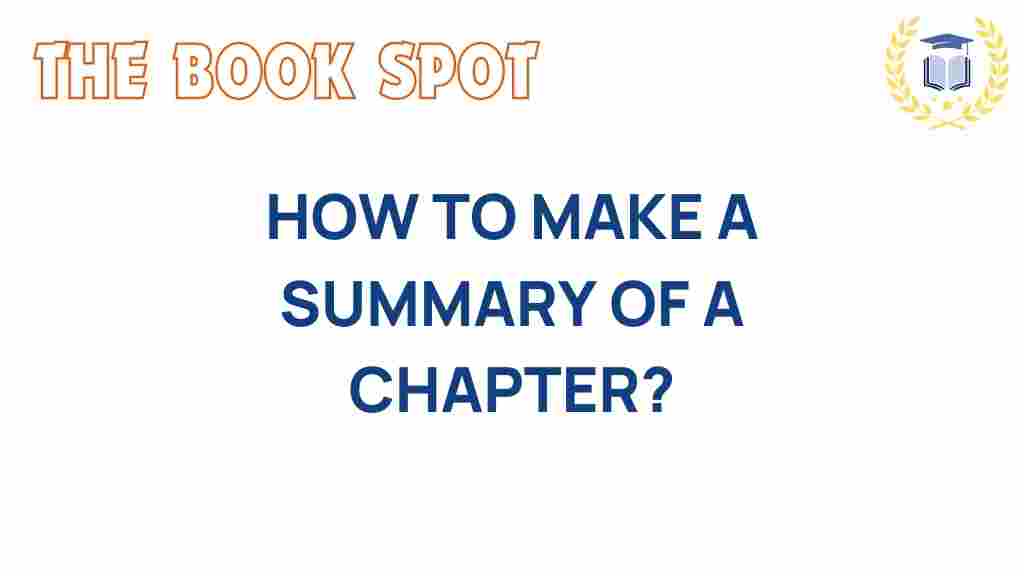Mastering Chapter Summaries: A Guide to Effective Comprehension
In the realm of education, understanding material is crucial for success. One of the most effective academic skills you can develop is the ability to create concise and informative chapter summaries. These summaries not only aid in recall but also enhance effective comprehension, allowing you to grasp complex ideas and concepts more easily. In this guide, we will explore various study techniques, reading strategies, and summarization tips to help you master the art of chapter summaries.
Why Chapter Summaries Matter
Chapter summaries serve as invaluable tools in the learning process. Here are some reasons why they are essential:
- Enhances Retention: Summarizing information helps reinforce memory retention.
- Clarifies Understanding: Writing a summary forces you to process the material, leading to deeper understanding.
- Saves Time: Summaries provide quick references for exam preparation or review sessions.
- Improves Focus: Creating summaries encourages you to focus on key points rather than getting lost in details.
Step-by-Step Process for Creating Effective Chapter Summaries
Now that we understand the importance of chapter summaries, let’s delve into a systematic approach to creating them:
1. Read Actively
Before you can summarize, you must thoroughly understand the material. Use active reading techniques to engage with the text:
- Highlight Key Points: Use a highlighter to mark essential concepts and arguments.
- Take Marginal Notes: Jot down thoughts or questions in the margins as you read.
- Ask Questions: Challenge yourself with questions about the content to deepen your understanding.
2. Outline the Chapter
Creating an outline can help organize your thoughts before summarizing:
- Identify Main Ideas: Determine the central theme of the chapter.
- List Supporting Details: Write down significant points that support the main ideas.
- Use Bullet Points: Organize information in bullet points for clarity.
3. Write the Summary
With your outline in hand, you can now draft your summary. Aim for clarity and conciseness:
- Use Your Own Words: Paraphrase the material to ensure comprehension.
- Keep It Brief: Limit your summary to a few paragraphs, focusing on key points.
- Stay Objective: Avoid inserting personal opinions; stick to the facts presented in the text.
4. Review and Revise
After drafting your summary, take time to review and refine it:
- Check for Accuracy: Ensure all key points from the chapter are included.
- Eliminate Redundancies: Remove any repetitive information.
- Seek Feedback: Share your summary with peers or teachers for constructive criticism.
Troubleshooting Common Issues
Even with a systematic approach, you may encounter challenges. Here are some common issues and solutions:
Problem 1: Overwhelming Information
Solution: If the chapter feels too dense, break it down into smaller sections. Summarize each section individually before combining them.
Problem 2: Difficulty Identifying Key Points
Solution: Focus on headings, subheadings, and bolded text which often indicate important concepts. Consider using graphic organizers to visualize relationships between ideas.
Problem 3: Lack of Time
Solution: Prioritize your reading and summarization. Use techniques such as skimming for main ideas and scanning for details to save time. Set a timer to keep yourself focused and efficient.
Effective Comprehension Through Educational Methods
To master chapter summaries and improve effective comprehension, consider incorporating various educational methods into your study routine:
- Visual Aids: Use charts, diagrams, or mind maps to represent information visually.
- Discussion Groups: Engage with peers in study groups to discuss and clarify concepts.
- Flashcards: Create flashcards for key terms and concepts to reinforce memory.
Utilizing Learning Tools
With advancements in technology, many learning tools are available to assist in the summarization process:
- Note-Taking Apps: Use apps like Evernote or OneNote to organize notes and summaries electronically.
- Summarization Software: Tools like Resoomer can help generate summaries from larger texts.
- Online Resources: Websites like Khan Academy offer supplementary instructional materials.
Conclusion
Mastering chapter summaries is a vital skill that enhances your academic performance and promotes effective comprehension. By adopting the outlined strategies, you can improve your understanding of complex subjects and retain information more effectively. Remember to practice regularly, seek feedback, and utilize various educational methods and learning tools to refine your summarization skills. With dedication and the right approach, you’ll find chapter summaries to be an essential part of your study routine.
By incorporating these techniques into your academic life, you can elevate your learning experience and achieve your educational goals with confidence. Start summarizing today and unlock the full potential of your comprehension skills!
This article is in the category Guides and created by TheBookSpot Team
